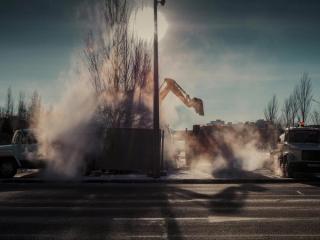Proposals that impact upon air quality, or result in new exposure to potential pollutants, must be supported by an air quality assessment. This may be a basic (or screening) assessment or a complex detailed dispersion modelling assessment. SLR’s Air Quality team can support you with this, please get in touch.
In the UK, all applications for major developments, and any with car parking spaces above a certain threshold, typically require an Air Quality Assessment (AQA), which will address the air quality impacts of both the construction and operational phases of the development on human health and ecological receptors.
The exact requirements and thresholds vary by planning authority and may be detailed in planning validation requirements, supplementary planning documents, policy documents, or simply by the Environmental Health Officer during consultation.
Typically, impacts requiring assessment arise from dust generated during demolition and / or construction works, emissions from plant, or from the traffic generated by the development. Where impacts are identified, they may require proposal of mitigation measures, sometimes supported by damage cost calculations.
What information should be included in an air quality assessment?
The information that should be included in an air quality assessment for a planning application will differ depending upon the proposed development and the local requirements. In general air quality assessments can be divided into basic assessments and detailed assessments.
Basic air quality assessment
This may include:
- a review of baseline air quality around the development site and affected road links, typically this can be achieved using existing published air quality monitoring and / or modelling data from the local authority or Defra, in the UK.
- an assessment of the impact on air quality during the construction phase. There is a standard methodology for assessment of construction dust impacts from the Institute for Air Quality Management, or variation of its guidance, adopted by most authorities. This takes a risk-based approach to defining appropriate mitigation for controlling dust and pollution emissions associated with plant and vehicles.
- screening of predicted traffic generation of the development, against threshold levels, to inform the requirement, if any, for detailed assessment.
- identification of receptors (potential exposure locations) which may be subject to a worsening of air quality as a result of the development, for example, due to traffic increases, or consideration of the potential exposure of new receptors (e.g. if building in an Air Quality Management Area).
- consideration of the significance of the air quality effects, and whether they are a material constraint to development.
- a description of mitigation measures to be incorporated into the design, either to mitigate off-site impacts (e.g. promotion of sustainable travel solutions), or to mitigate exposure of occupants of the new development e.g. measures to reduce exposure such as green infrastructure, orientation or elevation of residential areas, building ventilation and (NOx / particulate) filtration requirement (the latter may require support using detailed methodology, see below).
Detailed air quality assessment
Detailed air quality assessment would typically incorporate most of the elements of the basic assessment but may additionally include:
- air quality monitoring – deploying automated or passive (diffusion tube) type monitoring at potential exposure locations of interest.
- air quality dispersion modelling of either traffic emissions or combustion plant such as boilers, biomass boilers, combined heat and power plants (CHPs), or other industrial processes.
For a traffic emissions dispersion modelling assessment this would require:
- a model validation / verification assessment, where model predictions, based on recent measured traffic flow data are compared to air quality monitoring data for the same period to assess the accuracy of the model.
- the prediction of future air quality without the development in place (the future baseline or ‘without development’ scenario) at the receptor points of concern.
- the prediction of future air quality with the development in place (the ‘with development’ scenario) with predicted future road transport emissions.
- this may lead to an additional scenario with the prediction of future air quality with the development with identified mitigation measures in place.
Air quality mitigation requirements
Developments may need to incorporate specific air quality mitigation, either to reduce the predicted impacts to acceptable levels or as a result of planning policy (e.g. established policy requirements include Low NOx Boilers and numbers of Electric Vehicle charging points). Typical mechanisms to facilitate mitigation include:
- Air Quality Neutral / Air Quality Positive assessments in London – use of emissions benchmarks based upon building energy usage and car trips to determine impact compensation or abatement compensation.
- Damage Cost Calculations - impact costs per tonne of emission by pollutant, based on theoretical societal costs to inform the scale of the required investment in air quality mitigation or off-setting measures.
- Dispersion modelling assessments – these allow detailed consideration of design strategies, whether this be locations of residential occupancy, ventilations strategies (e.g. passive or active incorporating air filtration).
Who to contact for an Air Quality Assessment
SLR’s Air Quality team can help with all aspects of air quality assessment needed to support your planning application, including:
- Basic air quality assessments
- Detailed dispersion modelling assessments
- Indoor air quality assessment
- Air Quality Neutral Statements
- Air Quality Positive Statements
- Damage Cost Calculations
- Emissions Mitigation Assessments
- Ambient air quality monitoring
- Indoor Air Quality Monitoring (BREEAM HEA-02)
- Construction dust assessments
- Odour Impact Assessments
- Expert Witness
If you would like further information please send us an enquiry and we’ll get back to you.




